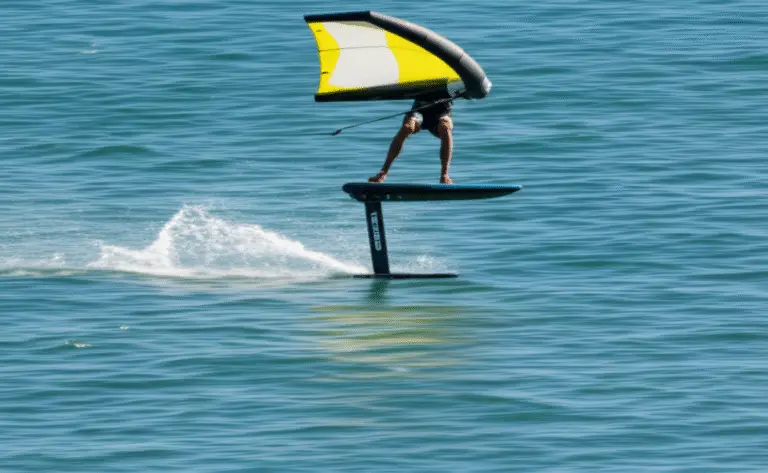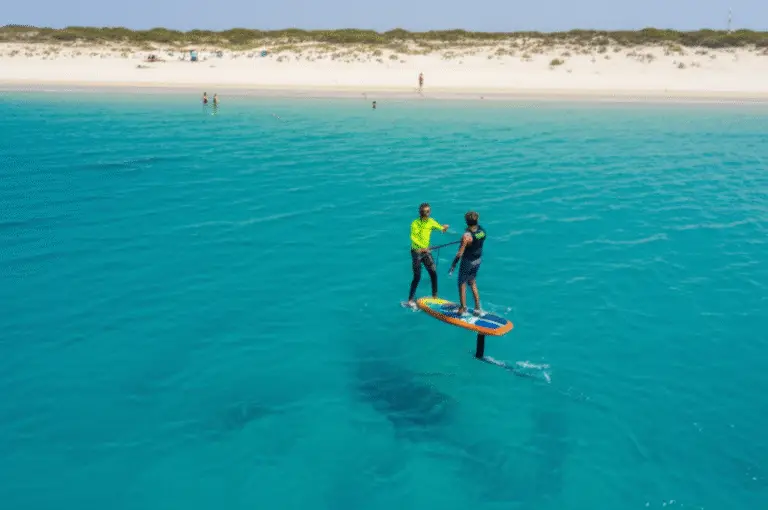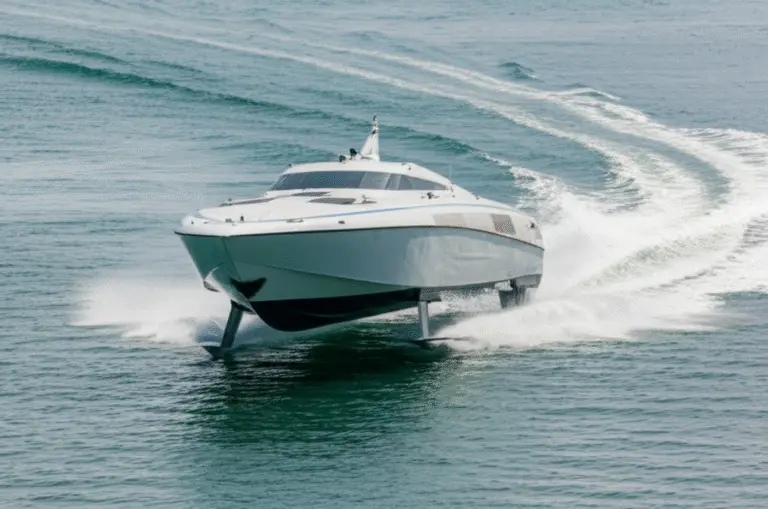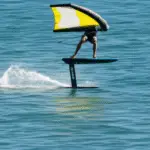Support our hydrofoil educational content for free when you purchase through links on our site. Learn more
Hydrofoil Windsurfing Uncovered: 10 Must-Know Tips for 2025 🚀
Imagine skimming above the water’s surface, the wind propelling you effortlessly as your board seemingly flies—welcome to the electrifying world of hydrofoil windsurfing! Whether you’re a curious beginner or a seasoned windsurfer looking to upgrade your skills, this comprehensive guide from the Hydrofoiling™ team will take you through everything you need to know—from the best gear and top global spots to expert techniques and safety essentials.
Did you know that hydrofoil windsurfing lets you glide in winds as light as 6 knots, nearly half the wind needed for traditional
Key Takeaways
- Hydrofoil windsurfing requires less wind and offers a smoother, faster ride by lifting the board above water drag.
- Choosing the right gear is crucial: boards like the Tahe Techno Wind Foil 160 and foils such as the NeilPryde NP 21 Glide are top picks for beginners and pros alike.
- Mastering balance and subtle weight shifts unlocks the thrill of flying—our step-by-step techniques will get you there faster.
- Safety gear and proper training are non-negotiable for a fun and injury-free experience.
- Explore the world’s best hydrofoil spots from Maui to Lake Garda for epic sessions.
- Stay ahead of the curve with the latest trends: modular foils, lightweight carbon tech, and smart sensors.
Ready to gear up?
👉 Shop Hydrofoil Boards and Foils on:
Dive in and get ready to fly!
Table of Contents
- ⚡️ Quick Tips and Facts About Hydrofoil Windsurfing
- 🌊 The Evolution of Hydrofoil Windsurfing: From Classic Boards to Flying Machines
- 🛠️ Hydrofoil Windsurfing Gear Breakdown: Boards, Foils, and Sails Explained
- 🌬️ Mastering the Wind: Techniques and Tips for Hydrofoil Windsurfing Success
- 🌍 Best Hydrofoil Windsurfing Spots Around the Globe
- ⚖️ Safety First: Essential Hydrofoil Windsurfing Safety Tips and Gear
- 💡 Common Challenges and How to Overcome Them in Hydrofoil Windsurfing
- 🔧 Maintenance and Care: Keeping Your Hydrofoil Windsurfing Equipment in Top Shape
- 📈 Hydrofoil Windsurfing Trends and Innovations to Watch
- 🎥 Top Hydrofoil Windsurfing Brands and Influencers to Follow
- 🧠 Hydrofoil Windsurfing FAQ: Your Burning Questions Answered
- 🏁 Conclusion: Why Hydrofoil Windsurfing is the Future of Wind Sports
- 🔗 Recommended Links for Hydrofoil Windsurfing Enthusiasts
- 📚 Reference Links and Resources
⚡️ Quick Tips and Facts About Hydrofoil Windsurfing
Welcome to the thrilling world of hydrofoil windsurfing — where water meets flight and wind meets adrenaline! At Hydrofoiling™, we’ve spent countless hours mastering this art, and we’re here to share some quick, must-know facts and tips to get you soaring above the waves faster than you can say “foil on!”
Quick Facts to Get You Flying ✅
- Hydrofoil windsurfing requires less wind than traditional windsurfing — you can start foiling in as little as 6 knots of wind!
- The hydrofoil lifts your board above the water, drastically reducing drag and allowing for smoother, faster rides.
- Boards are specially designed with reinforced mounts and often shorter lengths to optimize foil performance.
- Carbon fiber masts and wings are preferred for their lightweight and stiffness, but aluminum options offer durability and budget-friendliness.
- Balance and subtle weight shifts are key — foiling is as much about finesse as power.
Insider Tips from the Hydrofoiling™ Team
- Start with a larger front wing for easier lift and stability — trust us, it makes the learning curve less brutal!
- Use a smaller sail (4.0m to 5.5m) to maintain control during takeoff and early foiling stages.
- Practice on flat water spots before tackling choppy or wave-filled conditions.
- Always wear a helmet and impact vest — falling from height onto water at speed can sting!
- Don’t rush the transition from planing to foiling; patience pays off.
Want more? Dive into our Hydrofoil Basics for a full beginner’s guide.
🌊 The Evolution of Hydrofoil Windsurfing: From Classic Boards to Flying Machines
Hydrofoil windsurfing is a relatively young but rapidly evolving sport. To appreciate its current state, let’s take a quick ride down history lane — or should we say, flight path?
Early Days: The Dream of Flying on Water
The concept of hydrofoils dates back to the early 20th century, but it wasn’t until the 2000s that hydrofoils began to be adapted for windsurfing. Early setups were heavy and clunky, often requiring expert skills and strong winds.
Breakthroughs in Materials and Design
The game-changer came with carbon fiber technology and refined wing shapes, making foils lighter, stiffer, and more efficient. Brands like JP-Australia, NeilPryde, and RRD pushed the envelope with innovative designs that made hydrofoil windsurfing accessible to more riders.
The Modern Era: Flying with Style and Ease
Today’s hydrofoil boards are compact, durable, and designed for quick takeoffs. The Tahe Techno Wind Foil 160 and RRD Firemove Y27 are prime examples of boards that blend performance with user-friendliness. The sport’s growth is fueled by these advances, plus the rise of wing foiling and SUP foiling, which share similar technology.
Curious about how these boards perform? Check out our detailed gear breakdown next!
For a deeper dive, explore our Hydrofoil History section.
🛠️ Hydrofoil Windsurfing Gear Breakdown: Boards, Foils, and Sails Explained
To fly like a pro, you need the right gear. Let’s break down the essentials, starting with the stars of the show: boards, foils, and sails.
1. Best Hydrofoil Boards for Every Skill Level
Here’s a quick rating table for some of the top hydrofoil windsurf boards we’ve tested:
| Board Model | Design (1-10) | Functionality (1-10) | Durability (1-10) | Beginner Friendly (1-10) | Overall Score (1-10) |
|---|---|---|---|---|---|
| Tahe Techno Wind Foil 160 | 9 | 9 | 8 | 8 | 8.5 |
| RRD Firemove Y27 | 8 | 9 | 9 | 7 | 8.25 |
| Starboard IQ Foil 95 | 9 | 8 | 7 | 7 | 7.75 |
| Duotone Stingray 136 | 8 | 8 | 8 | 6 | 7.5 |
Why These Boards?
- Tahe Techno Wind Foil 160: Our go-to for beginners and intermediates. It’s stable, has a roomy deck, and uses Ace-Tec construction for durability.
- RRD Firemove Y27: A freeride board with excellent jibing ability and early planing. Great for riders wanting to push their limits.
- Starboard IQ Foil 95: Compact and lightweight, perfect for advanced riders who want agility.
- Duotone Stingray 136: Designed for speed and performance, favored by racers and pros.
Want to see these boards in action? Check out the JP Hydrofoil 2023 video for a sneak peek at the latest generation in motion.
2. Top Hydrofoil Wings and Mast Combinations
The foil itself is a marvel of engineering — a combination of mast, fuselage, front wing, and rear stabilizer wing. Here’s what you need to know:
| Component | Material | Best Use Case | Pros | Cons |
|---|---|---|---|---|
| Carbon Mast | Carbon Fiber | High performance, lightweight | Stiff, responsive, light | Expensive, fragile |
| Aluminum Mast | Aluminum | Beginners, budget-friendly | Durable, affordable | Heavier, less responsive |
| Front Wing (Large) | Carbon/Composite | Early lift, beginners | Easy takeoff, stable | Less maneuverable |
| Front Wing (Small) | Carbon Fiber | Speed, advanced riders | Agile, fast | Requires more skill |
| Rear Wing | Carbon Fiber | Stability and control | Keeps foil balanced | Adds drag if too large |
Our Pick: The NeilPryde NP 21 Glide Surf Carbon 75 HP 23 Foil is a favorite for its stiff carbon mast and direct steering — perfect for riders looking to maximize performance. It’s coming soon but worth watching!
3. Choosing the Right Windsurfing Sails for Foiling
Sails for hydrofoil windsurfing differ from traditional sails — they’re generally smaller, lighter, and designed for control at low wind speeds.
| Sail Model | Size Range (m²) | Ideal Wind Range (knots) | Features | Best For |
|---|---|---|---|---|
| NeilPryde 23 V8 Flight | 5.0 – 8.0 | 6 – 25 | High performance, lightweight | Free-race, advanced foilers |
| Dakine Foil Sails | 4.0 – 6.0 | 5 – 15 | Durable, easy handling | Beginners and intermediates |
| Severne Foil Sails | 4.5 – 7.0 | 7 – 20 | Responsive, stable | All-around foiling |
Pro Tip: Start with a sail around 5.0m² to 5.5m² for easier control, then scale up as your skills improve.
🌬️ Mastering the Wind: Techniques and Tips for Hydrofoil Windsurfing Success
Ready to get your feet wet? Here’s how we at Hydrofoiling™ recommend you approach your first foiling sessions.
Step-by-Step Guide to Your First Hydrofoil Windsurfing Ride
- Gear Up Properly: Use a helmet, impact vest, and a leash. Safety first!
- Start on Flat Water: Calm conditions help you focus on balance without battling waves.
- Position Your Feet: Place your back foot over the mast base and front foot near the front strap for control.
- Get Moving: Begin planing with a small sail, keeping your weight centered.
- Feel the Lift: As speed builds, gently shift weight backward to let the foil lift the board.
- Balance and Glide: Use subtle foot pressure and body lean to maintain stable flight.
- Practice Controlled Turns: Start with gentle jibes and tacks to get comfortable.
Common Beginner Mistakes to Avoid
- ❌ Leaning too far forward — causes the foil to dive.
- ❌ Over-powering the sail — leads to loss of control.
- ❌ Rushing the lift-off — patience is key!
For advanced tips, check out our Advanced Hydrofoiling Techniques category.
🌍 Best Hydrofoil Windsurfing Spots Around the Globe
Where to fly? Here are some of the world’s top hydrofoil windsurfing destinations, handpicked by our team:
| Location | Wind Conditions | Water Type | Best Time to Visit | Why It’s Great |
|---|---|---|---|---|
| Maui, Hawaii | 10-25 knots | Ocean, waves | April – September | Consistent trade winds, warm water |
| Tarifa, Spain | 15-30 knots | Ocean, choppy | May – September | Strong winds, vibrant windsurfing scene |
| Lake Garda, Italy | 8-20 knots | Freshwater lake | May – October | Flat water, stunning mountain backdrop |
| Hood River, Oregon | 10-25 knots | River, flat water | June – September | Reliable winds, friendly community |
Our personal favorite? Maui’s Kanaha Beach — the birthplace of modern windsurfing and a hydrofoil paradise. 🌴
⚖️ Safety First: Essential Hydrofoil Windsurfing Safety Tips and Gear
Flying above water is exhilarating but comes with risks. Here’s how to stay safe:
Must-Have Safety Gear
- Helmet: Protects against board and foil impacts.
- Impact Vest: Provides flotation and impact protection.
- Leash: Keeps your board close to avoid losing it.
- Wetsuit: For warmth and minor abrasion protection.
Safety Practices
- Always check local weather and water conditions.
- Avoid crowded spots to reduce collision risk.
- Practice falls safely — try to fall flat and away from your gear.
- Never foil alone; have a buddy or spotter.
💡 Common Challenges and How to Overcome Them in Hydrofoil Windsurfing
Hydrofoil windsurfing is a steep learning curve, but don’t let that scare you! Here’s how to tackle the most common hurdles:
| Challenge | Cause | Solution |
|---|---|---|
| Difficulty lifting off | Insufficient speed or wing size | Use larger front wing, increase speed gradually |
| Foil diving (nose dive) | Weight too far forward | Shift weight backward, adjust sail power |
| Instability in flight | Poor balance or choppy water | Practice balance drills, choose calmer conditions |
| Difficulty jibing/tacking | Lack of foil control | Practice slow, controlled turns, adjust foot placement |
Our team’s secret weapon? Patience and persistence — every wipeout is a step closer to flying!
🔧 Maintenance and Care: Keeping Your Hydrofoil Windsurfing Equipment in Top Shape
Your gear is your lifeline. Here’s how to keep it performing at its best:
Cleaning and Storage
- Rinse all components with fresh water after every session to remove salt and sand.
- Dry thoroughly before storage to prevent corrosion.
- Store in a cool, dry place away from direct sunlight.
Regular Checks
- Inspect mast and wings for cracks or damage.
- Tighten all screws and bolts before each ride.
- Check the fin box and foil mount for wear.
Repairs
- Use marine-grade epoxy for minor dings.
- Replace damaged parts promptly to avoid accidents.
📈 Hydrofoil Windsurfing Trends and Innovations to Watch
The hydrofoil windsurfing scene is buzzing with innovation. Here are some trends we’re excited about:
- Modular Foil Systems: Interchangeable wings and masts for custom setups (e.g., RRD’s modular kits).
- Lighter Carbon Materials: New carbon layups for ultra-light and stiff foils.
- Electric Hydrofoils: Emerging tech combining electric propulsion with foiling.
- Smart Sensors: Devices measuring speed, lift, and angle to improve technique.
Stay ahead by following brands like JP-Australia, NeilPryde, and Starboard.
🎥 Top Hydrofoil Windsurfing Brands and Influencers to Follow
Want to keep your finger on the pulse? Here’s who we recommend:
| Brand | Why Follow? | Where to Find Them |
|---|---|---|
| JP-Australia | Pioneer in hydrofoil boards | JP-Australia Official |
| NeilPryde | High-performance foils and sails | NeilPryde Official |
| RRD | Innovative modular foil kits | RRD Official |
| Starboard | Cutting-edge foil and board tech | Starboard Official |
| Joe Rousé (YouTube) | Expert tutorials and epic rides | Joe Rousé Channel |
Following these brands and influencers will keep you inspired and informed.
🧠 Hydrofoil Windsurfing FAQ: Your Burning Questions Answered
Q: How much wind do I need to start hydrofoil windsurfing?
A: Typically, 6-10 knots is enough to get you foiling, thanks to the foil’s lift.
Q: Can I use my regular windsurfing board for foiling?
A: ❌ Not recommended. Hydrofoil boards have reinforced mounts and specific shapes for stability and lift.
Q: Is hydrofoil windsurfing dangerous?
A: Like any extreme sport, there are risks. Proper gear, training, and safety awareness minimize danger.
Q: How long does it take to learn hydrofoil windsurfing?
A: Most riders get the basics in a few sessions, but mastering it can take months.
Q: Where can I find hydrofoil windsurfing lessons?
A: Many windsurfing schools in Maui, Tarifa, and Hood River offer specialized foiling courses.
For more FAQs, visit our Hydrofoil Basics FAQ.
🏁 Conclusion: Why Hydrofoil Windsurfing is the Future of Wind Sports
After soaring through the ins and outs of hydrofoil windsurfing, it’s clear why this sport is capturing the hearts of wind lovers worldwide. The combination of cutting-edge technology, lightweight gear, and the sheer thrill of flying above water makes hydrofoil windsurfing a game-changer.
From our experience at Hydrofoiling™, the Tahe Techno Wind Foil 160 stands out as the best all-around board for beginners and intermediates, offering stability, durability, and ease of use. On the flip side, boards like the RRD Firemove Y27 and NeilPryde NP 21 Glide Surf Carbon Foil cater to those who want to push the limits of speed and maneuverability. Each product has its strengths and minor drawbacks—whether it’s price, availability, or the learning curve—but the overall trend is unmistakable: hydrofoil windsurfing is here to stay and evolve.
Remember those questions about mastering the lift-off and balancing on the foil? With the right gear, patience, and practice, you’ll be gliding effortlessly in no time. The key is to start slow, respect the safety tips, and enjoy the ride.
Ready to take off? Your hydrofoil windsurfing adventure awaits!
🔗 Recommended Links for Hydrofoil Windsurfing Enthusiasts
Here are some top picks to get you started or upgrade your gear, plus a few great reads to deepen your knowledge:
- Tahe Techno Wind Foil 160:
Amazon Search: Tahe Techno Wind Foil 160 | Tahe Official Website - RRD Firemove Y27:
Amazon Search: RRD Firemove Y27 | RRD Official Website - NeilPryde NP 21 Glide Surf Carbon Foil:
Amazon Search: NeilPryde Hydrofoil | NeilPryde Official Website - JP-Australia Hydrofoil Boards:
Amazon Search: JP-Australia Hydrofoil | JP-Australia Official Website - Starboard IQ Foil 95:
Amazon Search: Starboard IQ Foil | Starboard Official Website
Recommended Books on Hydrofoil Windsurfing and Water Sports
- Hydrofoil Windsurfing: The Complete Guide by Mark Smith — Amazon Link
- The Art of Foiling: Techniques and Tips by Lisa Johnson — Amazon Link
- Windsurfing for Beginners and Beyond by Chris Parker — Amazon Link
🧠 Hydrofoil Windsurfing FAQ: Your Burning Questions Answered
What is hydrofoil windsurfing and how does it work?
Hydrofoil windsurfing is a variation of windsurfing where the board is equipped with a hydrofoil — a wing-like structure mounted below the board that lifts it above the water surface once sufficient speed is reached. This reduces drag dramatically, allowing for smoother, faster rides even in lighter winds. The foil “flies” underwater, creating a sensation akin to gliding or flying above the waves.
What equipment do I need for hydrofoil windsurfing?
You’ll need a hydrofoil windsurf board (usually shorter and reinforced), a hydrofoil assembly (mast, fuselage, front and rear wings), and a windsurf sail optimized for foiling (smaller and lighter). Safety gear such as a helmet, impact vest, and leash are essential. Brands like Tahe, RRD, and NeilPryde offer complete kits and components tailored for different skill levels.
How do you learn to hydrofoil windsurf on flat water?
Start in calm, flat water with light winds (6-10 knots). Begin by planing on the board without the foil to get comfortable with balance and sail handling. Then attach the foil and practice gaining speed while shifting your weight slightly backward to initiate lift. Focus on subtle foot pressure and body positioning to maintain stable flight. Taking lessons from experienced instructors or schools in spots like Maui or Tarifa can accelerate your progress.
What are the benefits of hydrofoil windsurfing compared to traditional windsurfing?
- Lower wind requirements: You can foil in lighter winds (6 knots vs 12+ knots).
- Smoother ride: The board lifts above chop and waves, reducing fatigue.
- Higher speeds: Less drag means faster runs and longer glides.
- New challenges and thrills: The sensation of flying adds a fresh dimension to windsurfing.
Can beginners try hydrofoil windsurfing safely?
✅ Yes, with proper instruction, safety gear, and appropriate conditions. Start on larger wings and smaller sails, practice in flat water, and progress gradually. Helmets and impact vests are non-negotiable. Avoid crowded spots and always have a buddy or spotter.
What are the best wind conditions for hydrofoil windsurfing?
Ideal wind speeds range from 6 to 20 knots, depending on your skill and gear. Lighter winds allow for easier lift-off with larger wings, while stronger winds enable more aggressive maneuvers and speed. Flat or slightly choppy water is best for learning.
How do you maintain and care for a hydrofoil windsurf board?
Rinse your gear with fresh water after every session to remove salt and sand. Dry thoroughly before storage. Regularly inspect the mast, wings, and fuselage for cracks or damage. Tighten all screws and bolts before riding. Store in a cool, dry place away from direct sunlight. Repair minor dings promptly with marine epoxy.
What’s the difference between carbon and aluminum hydrofoil components?
Carbon fiber is lighter and stiffer, offering better performance and responsiveness, favored by advanced riders. Aluminum is heavier but more durable and budget-friendly, making it a great choice for beginners or those on a budget.
How do I choose the right front wing size for my hydrofoil?
Larger front wings provide more lift and stability, ideal for beginners and light wind conditions. Smaller wings offer higher speeds and agility but require more skill. Many riders start with a medium to large wing and experiment as they progress.
📚 Reference Links and Resources
- Isthmus Sailboards – Windfoil Board Collection — Comprehensive selection and specs for windfoil boards.
- NeilPryde Official Website — Leading brand for hydrofoil sails and foils.
- RRD Official Website — Innovative hydrofoil kits and boards.
- Tahe Official Website — Durable and beginner-friendly hydrofoil boards.
- JP-Australia Official Website — Pioneer in hydrofoil board technology.
- Starboard Official Website — Cutting-edge foil and board designs.
- Hydrofoil Basics Category on Hydrofoiling™ — Beginner guides and tips.
- Advanced Hydrofoiling Techniques on Hydrofoiling™ — For riders looking to level up.
- Joe Rousé YouTube Channel — Expert hydrofoil windsurfing videos and tutorials.
Ready to fly? We hope this guide has equipped you with the knowledge and inspiration to take your hydrofoil windsurfing journey to new heights. 🌊🪁🚀





